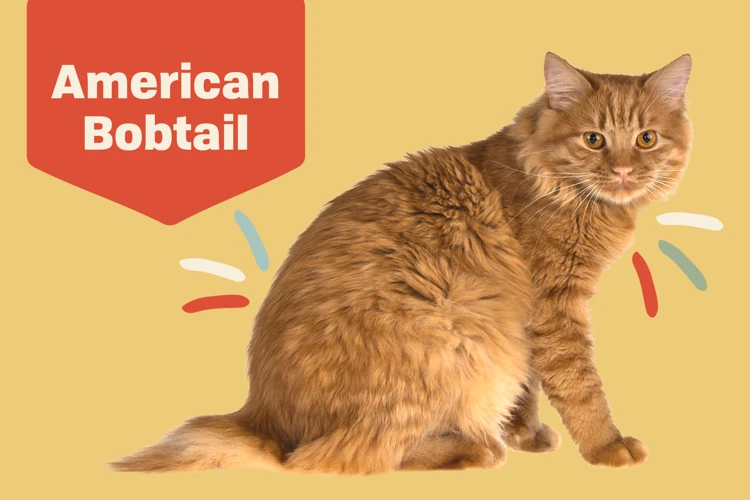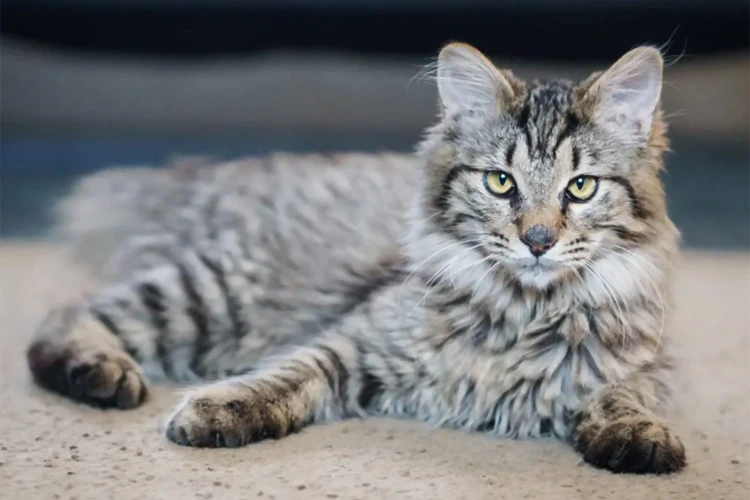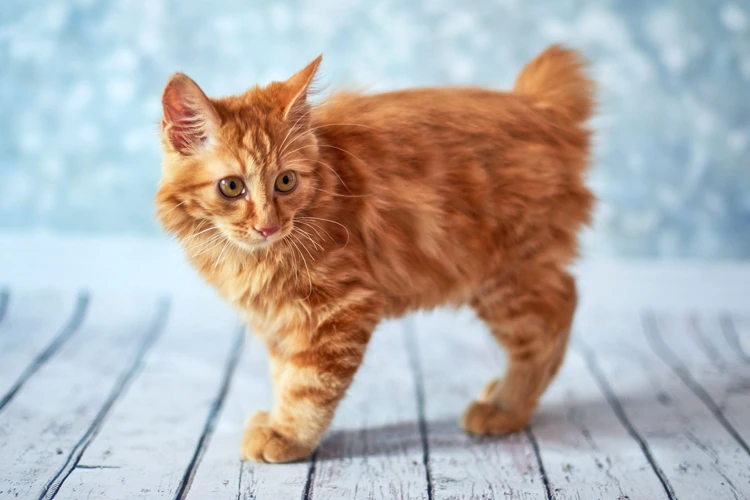Are you a cat owner who is searching for a new way to train your American Bobtail? Clicker training may be just what you’re looking for! This unique method of training uses positive reinforcement to encourage good behavior and can be a fun and effective way to bond with your furry friend. In this article, we’ll explore the ins and outs of clicker training and provide step-by-step guidance on how to get started. From the basics of what a clicker is to teaching your cat fun tricks, we’ll cover everything you need to know to begin your clicker training journey with your American Bobtail. So, let’s get started!
What is Clicker Training?

Have you ever wondered how to train your American Bobtail? Clicker training may be the answer. This positive reinforcement training method uses a distinct sound, a clicker, to mark a desirable behavior in your cat. Clicker training is not only an effective way to teach basic commands but also fun tricks. In this section, we will discuss what clicker training is and how it works. Additionally, we will provide step-by-step guidance on how to get started with training your American Bobtail using clicker training. Before we dive in, consider reading about your cat’s body language in our article “Understanding Your American Bobtail’s Body Language” to help you communicate better with your furry friend.
What is a Clicker?
A clicker is a small mechanical device used to help train pets by creating a distinct sound that marks the desired behavior. Clicker training is a form of operant conditioning that uses positive reinforcement to reward desirable behaviors. It’s a safe and effective training method that can be used on a wide range of animals, including cats like the American Bobtail.
Clickers offer several advantages over other training methods. They produce an identical sound every time they’re clicked, which helps keep training consistent. Also, the clicking sound is unique and not used in everyday life, so it’s not easy for the pet to confuse it with any other noise.
Using a clicker as a training tool creates a positive association between the sound of the click and the reward that follows. That means your American Bobtail will learn to associate the click with getting a treat or praise. This helps create a positive learning environment for your cat, helps build their confidence, and can even improve their overall behavior.
To use a clicker properly, you need to introduce and associate it with positive experiences. This starts with getting your cat used to the sound of the clicker. Here are some basic steps for introducing your cat to the clicker:
| Step | Action |
|---|---|
| Step 1: | Choose a quiet room with no distractions. |
| Step 2: | Click the button on the clicker and immediately reward your cat with a treat or praise. |
| Step 3: | Repeat Step 2 several times until your cat associates the sound of the click with receiving a treat or praise. |
| Step 4: | Start using the clicker during training sessions to mark desirable behaviors and reward your cat for those behaviors. |
By using the clicker to consistently reinforce your cat’s positive behavior, you can create a fun and effective training experience. Your American Bobtail kitten will be motivated to learn and look forward to training sessions. Keep in mind, like any training method, clicker training takes time and patience. The key is to stay consistent and keep training sessions short, sweet, and fun.
Now that you know more about what a clicker is, let’s dive into how it works and how you can incorporate it into your training with your American Bobtail.
How Does Clicker Training Work?
Clicker training is a form of positive reinforcement training that is highly effective for cats, including American Bobtails. This type of training works by creating an association between a behavior and a positive consequence, such as a treat.
Here’s how clicker training works:
- The trainer clicks the clicker when the cat performs the desired behavior.
- Immediately after the click, the cat is given a treat.
- The cat learns to associate the click with the treat, and therefore with the behavior that led to the click.
- Over time, the cat will begin to perform the behavior more consistently in order to receive the click and treat.
Using a clicker allows for precise timing in training, as the click can be delivered at the exact moment the desired behavior is performed. This makes it easier for the cat to understand what behavior is being rewarded.
Clicker training also has the added benefit of allowing for a “marker signal” that tells the cat exactly which behavior was rewarded. This can help to speed up the learning process for new behaviors.
Overall Benefits: Clicker training is a force-free, positive reinforcement training method that can be highly effective for American Bobtail cats. By using rewards instead of punishment, trainers can create a positive training experience that will improve the bond between the cat and owner. Additionally, clicker training can be used to address common behavior problems in American Bobtails, including issues with scratching, litter box use, and aggression. To learn more about the benefits of reward-based training, check out our page on The Benefits of Reward-Based Training for American Bobtails.
Now that we understand how clicker training works, let’s move on to the next section to learn what supplies you’ll need to get started with training your American Bobtail.
Getting Started with Clicker Training

Preparing to start clicker training with your American Bobtail is exciting and rewarding for both you and your furry friend. Before starting, there are a few important things you should know about gathering supplies and choosing the right treats. Clicker training is a great way to bond with your cat and teach them new skills and behaviors. Plus, it’s a useful tool for preventing and correcting common behavior problems in American Bobtails. So let’s dive in and get started! If you’re dealing with common behavior problems, check out our article on solving common behavior problems in American Bobtails.
Gather Your Supplies
Before you start clicker training your American Bobtail, it’s important to gather all the necessary supplies. You will need a clicker, treats, and a calm and quiet training environment.
Clicker: A clicker is an essential tool for clicker training. This small handheld device makes a distinct clicking sound that lets the cat know when they’ve done something right.
Treats: Treats are a crucial part of positive reinforcement training. Make sure to choose small, bite-sized treats that your cat loves. Avoid using their regular food as a treat, as they may not be as motivated to work for it.
Training environment: When starting clicker training, it’s important to choose a quiet and calm training environment. Pick a room where your cat feels safe and comfortable, and where there are minimal distractions.
Additional supplies: While not essential, it can be helpful to have a target stick or a leash and harness to assist in training specific behaviors. If you plan on taking your cat for walks or training outdoors, a leash and harness can be especially helpful. You can find more information about leash training in our article “How to Train Your American Bobtail on a Leash.”
Remember that every cat is unique and may have different preferences when it comes to treats and training environments. It may take some trial and error to find the perfect fit for your American Bobtail kitten. You can also find more tips on raising American Bobtail kittens in our article “Socializing American Bobtail Kittens: Dos and Don’ts.”
Choose the Right Treats
When it comes to clicker training for American Bobtails, choosing the right treats is an important part of the process. Treats are the primary tool for positive reinforcement, so you want to make sure your cat is motivated by them. Here are some tips on how to choose the right treats:
- Quality: Make sure you choose treats made with real meat and high-quality ingredients. Avoid treats that contain by-products, fillers or artificial preservatives.
- Size: Use small, bite-size treats that your American Bobtail can easily swallow. You don’t want to give them something that is too big and potentially harmful.
- Flavor: Choose treats that your cat loves. Some popular flavors for cats include chicken, tuna, and salmon. You can also try different flavors to see which ones your cat prefers.
- Texture: Choose treats with a texture that your cat enjoys. Some cats prefer crunchy treats while others prefer soft treats. It’s best to experiment to see which ones your cat likes best.
Keep in mind that you should use treats sparingly for training purposes. You don’t want to overfeed your American Bobtail and risk obesity. Use treats only as a reward for positive behavior.
If you want to learn more about clicker training for American Bobtails, check out our guide to teaching basic commands or start with our introduction to American Bobtails if you’re new to the breed.
Teaching Basic Commands

As you begin clicker training with your American Bobtail, teaching basic commands is an important first step in their education. By using the clicker as a marker for good behavior and pairing it with treats, your cat will quickly learn to associate the clicking sound with positive reinforcement. From there, you can begin teaching essential commands like sit, come, and down. Through patience and consistency, your Bobtail will become a well-trained and obedient companion.
Sit
Teaching your American Bobtail how to sit is one of the easiest and most useful behaviors to train. It is a foundation for many other commands and will also help your cat learn patience and self-control. Here is a step-by-step guide on how to teach your American Bobtail to sit using clicker training:
| Step 1: | Get your cat’s attention by calling their name, then show them a treat to get them interested. |
| Step 2: | Hold the treat slightly above your cat’s head, so they have to look up and back. |
| Step 3: | As your cat raises their head, their bottom will naturally lower. The moment their bottom touches the ground, click the clicker and give them the treat. |
| Step 4: | Repeat this process several times until your cat begins to associate the click with the treat and the behavior. |
| Step 5: | Once your cat starts to sit consistently, say “sit” each time they perform the behavior. This will help them associate the command with the behavior. |
| Step 6: | Practice in different environments and with varying distractions to help solidify the behavior. |
Remember to keep training sessions short and positive. If your American Bobtail loses interest or gets frustrated, take a break and come back to it later. With consistency and patience, your cat will soon be sitting on command like a pro!
Come
Teaching your American Bobtail to come to you when called is an important command that could potentially keep them out of danger. It’s essential to train your cat to come to you on command, especially when taking them outside or in public areas. Here’s how you can train your American Bobtail to come on command step-by-step:
| Step | Instructions |
|---|---|
| Step 1: | Choose a quiet location with no distractions. Then, call your cat using their name and reinforcing it with a treat when they come to you. |
| Step 2: | Repeat this several times but try moving further away from your cat each time. |
| Step 3: | Once your cat becomes familiar with this command, gradually increase the distance between you and your cat, but don’t go too fast. Your cat should be able to hear and respond to your call. |
| Step 4: | Add the command “come” as your cat approaches you by saying “come” in a clear and firm tone. Then, reward them with treats. |
| Step 5: | Repeat the command “come” until your American Bobtail is consistently responding to the command. |
| Step 6: | Add distractions to the training. Try calling your cat from another room or when they are playing with toys. |
| Step 7: | As your American Bobtail gets more comfortable with the command, gradually reduce the treats while still offering praise. |
Note: It’s important to make sure your American Bobtail enjoys training sessions and does not associate them with punishment. If your cat loses interest or becomes distracted, end the session and try again later. With patience, consistency, and positive reinforcement, your American Bobtail will learn to come on command.
Down
Teaching your American Bobtail to “down” is an important command that can be used to get your cat to lay down on command. This command can be helpful for grooming or when you need to calm your cat down. Here are the steps to teach your American Bobtail how to “down.”
| Step 1: | Start with your cat in a seated position. |
| Step 2: | Take a treat and hold it close to your cat’s nose, then move it down to the ground. As your cat follows the treat with their head, they should naturally move into a laying down position. |
| Step 3: | As soon as your cat lays down, click the clicker and give your cat the treat. |
| Step 4: | Repeat this process several times until your cat begins to associate the “down” command with the action of laying down. |
| Step 5: | Start adding the verbal cue “down” as your cat begins to understand the action. Say “down” just before you move the treat and your cat should start laying down before you even move the treat. |
| Step 6: | Gradually start removing the treat and clicker as your cat starts to understand the command. Begin giving treats every other successful attempt, then every third and so on until your cat lays down on command without needing a treat every time. |
It’s important to stay positive and patient when teaching your American Bobtail new commands. Make sure to use a happy tone of voice and reward your cat with treats and praise. Remember to keep training sessions short and frequent. Practice the “down” command several times a day until your cat gets comfortable with it. With persistence and patience, your American Bobtail will have mastered the “down” command in no time.
Teaching Fun Tricks

Once your American Bobtail has mastered the basic commands through clicker training, it’s time to move onto teaching fun tricks! Teaching tricks is not only a great way to bond with your furry friend but also to impress friends and family with your cat’s talents. In this section, we will explore exciting tricks such as the High Five, Roll Over, and Shake, and how to train your American Bobtail to perform them with ease.
High Five
Teaching your American Bobtail a fun and impressive trick like the High Five is a great way to bond with your furry friend through positive reinforcement training. The high five is a simple trick that your cat can learn with patience and practice.
To teach your cat the high five, follow these steps:
| Step | Description |
|---|---|
| 1 | Hold a treat in your closed hand above your cat’s head to get your cat to stand on its hind legs. |
| 2 | When your cat reaches up with its paw to touch your hand, say “high five” and click the clicker. |
| 3 | Immediately give your cat the treat as a reward. |
| 4 | Repeat the steps above until your cat understands the command and starts responding to it consistently. |
| 5 | Gradually move your hand slightly to the side, away from your cat’s head, while still holding the treat. This will encourage your cat to reach out with its paw instead of jumping up. |
| 6 | When your cat touches your hand with its paw, say “high five” and click the clicker. |
| 7 | Immediately give your cat the treat as a reward. |
| 8 | Repeat the steps above until your cat understands the new hand position and starts responding to the command consistently. |
| 9 | Gradually reduce the amount of physical support you give your cat until it can perform the high five on its own. |
It is important to remember that your American Bobtail may require more or less time to learn the high five depending on its age, personality, and previous training experience. However, with patience and consistency, you can teach your cat this fun trick and create a strong bond through positive reinforcement training.
Roll Over
Rolling over is a fun trick that can impress your friends and family. It can also be a great way to exercise your American Bobtail and keep them mentally stimulated. But how can you teach your cat to roll over? Follow these steps:
Step 1: Start with the basic “down” command. Your cat should already be comfortable lying down on command. If not, take a step back and work on that first.
Step 2: Once your cat is lying down, use a treat to lure them onto their side. Hold the treat near their nose and move it slowly towards their shoulder. Your cat should naturally shift onto their side to reach the treat. As soon as they do, click the clicker and give them the treat.
Step 3: Repeat step 2 a few times, gradually moving the treat further towards their hip. Eventually, your cat should be lying fully on their side. Click and reward every time they roll over.
Step 4: Add a verbal cue like “roll over” as soon as your cat starts to roll to their side. This will help them associate the behavior with the command.
Step 5: Increase the difficulty by asking your cat for a full roll. Once they are lying on their side, use a treat to guide them over onto their back. Click and reward as soon as they complete the roll.
Here’s a table summarizing the steps:
| Step | Action |
|---|---|
| 1 | Start with “down” command |
| 2 | Lure onto side with treat |
| 3 | Click and reward for rolling onto side |
| 4 | Add verbal cue |
| 5 | Guide onto back for full roll |
Remember to always end a training session on a positive note, even if your cat hasn’t fully mastered the trick yet. With patience and consistency, your American Bobtail will be rolling over in no time!
Shake
Teaching your American Bobtail cat how to shake is a fun and impressive trick that can be easily taught with clicker training. In just a few simple steps, your cat can learn to shake paws on command.
Step 1: Get Your Cat in Position
Start by getting your cat in a sitting position in front of you. Hold out your hand with your palm facing up and your fingers slightly curled, as if you are going to shake hands with someone. You can also use a treat to lure your cat into this position.
Step 2: Click and Treat
When your cat touches your hand with their paw or even just moves their paw in your direction, immediately click your clicker and give them a treat. Repeat this step several times until your cat consistently reaches out to touch your hand.
Step 3: Add Verbal Cue
Once your cat is consistently touching your hand, add a verbal cue such as “shake” or “paw.” Say the cue just before presenting your hand and clicking when they touch it.
Step 4: Gradually Increase Difficulty
As your cat becomes more comfortable with the shake command, gradually increase the difficulty by raising your hand or presenting it to your cat at a different angle. You can also start gradually withholding the treat until your cat has completed the full shake motion.
Here’s a summary of the steps to teach your American Bobtail cat how to shake:
| Step | Instructions |
|---|---|
| 1 | Get your cat in a sitting position in front of you. |
| 2 | Click and treat when your cat touches your hand. |
| 3 | Add a verbal cue such as “shake.” |
| 4 | Gradually increase the difficulty by raising your hand or withholding the treat until your cat completes the full shake motion. |
Remember to keep training sessions short and positive, and always end on a high note. With consistent practice and patience, your American Bobtail cat can master the shake trick and impress all your friends and family.
Training Guidelines

As you embark on your journey of clicker training for your American Bobtail, it’s important to follow some basic guidelines to ensure success. With consistency and proper timing, your cat will be well on their way to learning basic commands and fun tricks. However, it’s important to be patient and persevere through any challenges that arise during training. Keep reading for some helpful training guidelines to keep in mind.
Timing is Everything
When it comes to clicker training for American Bobtails or any other breed of cat, timing plays a crucial role in the success of the training. A well-timed click followed by a treat can reinforce your cat’s good behavior, while a delayed or early click can confuse your pet and undermine your training efforts.
How to time your click: As soon as your cat performs the desired behavior, click the clicker and immediately follow it up with a treat. It’s important to click as soon as possible because cats have short attention spans and may not connect the click to their action if it’s too delayed.
How often to click: Consistency is key in clicker training. Click every time your cat performs the desired behavior you’re trying to train. If you’re teaching your cat to sit, for example, click every time the cat sits, even if it’s not a perfect sit. By clicking consistently, your cat will learn to associate the click with the behavior you’re trying to reinforce.
Avoiding accidental clicks: Accidental clicks can damage your training efforts. To avoid this, keep the clicker at a safe distance from your cat and only click when your cat performs the desired action. If your cat gets distracted or wanders away, don’t click.
Learning to time your clicks takes practice, so don’t get discouraged if it doesn’t go perfectly at first. Keep at it, and with consistency and patience, you’ll soon be clicking like a pro.
| Tips for Timing Success |
|---|
| Click as soon as your cat performs the desired behavior |
| Click consistently every time your cat performs the behavior |
| Avoid accidental clicks, keep the clicker at a safe distance |
Be Consistent
Consistency is crucial when it comes to clicker training your American Bobtail. Consistent training leads to consistent behavior. Make sure you are using the same command words and clicks every time. This way, your cat will know exactly what you want them to do. Additionally, use the same treats every time. This will lead to reliable responses, making it easier for your furry friend to learn.
To help you stay consistent, consider creating a training schedule. This will help ensure that you are training your American Bobtail on a regular basis. Consistency helps to establish a routine and reinforce learning. You should aim for short, frequent training sessions. Cats have short attention spans, so try to keep training sessions between 5-10 minutes.
Another important aspect of consistency is making sure that everyone in the household is on the same page. If you live with others, make sure that they are using the same command words, clicks, and treats. This will prevent confusion for your cat and help speed up the training process.
Consistency also applies to your attitude and demeanor. When you are training your American Bobtail, be patient, calm, and positive. Cats can sense fluctuations in human emotions and behavior, so it’s important to maintain a consistent mood throughout training sessions. Speak in a clear, calm voice, and avoid becoming frustrated or angry. This will help keep things positive and enjoyable for both you and your cat.
Here is a table to summarize the importance of consistency in clicker training your American Bobtail:
| Why Consistency is Important |
|---|
| Consistent training leads to consistent behavior |
| Establishes routine and reinforces learning |
| Prevents confusion for your cat |
| Maintains a positive experience for both you and your cat |
Remember, consistency is key when it comes to clicker training your American Bobtail. By following a consistent training schedule and using the same command words, clicks, and treats, you’ll be well on your way to a happy, well-trained cat.
End on a Positive Note
It’s essential to end each clicker training session on a high note by doing something your cat knows well and enjoys doing to reinforce their positive behavior. This ensures that your cat feels successful and is looking forward to the next training session. Here are some ways you can end training sessions positively:
- Give your cat a treat or offer extra affection when they succeed at a command. This will end the session on a happy note and show your cat that they did an excellent job.
- Never scold or punish your cat during a training session, even if they refuse to follow your commands. Positive reinforcement is the most effective way to train a cat, and negative reinforcement can harm the bond you share with them.
- If your cat becomes tired or disinterested during the session, don’t force them to continue. Instead, end it on a high note and try again later or on another day.
Remember that the purpose of clicker training is to strengthen your bond with your cat, so always end each session with positive reinforcement. Celebrate your cat’s successes, no matter how small they may seem. By doing so, your cat will enjoy training sessions, and you’ll enjoy working with them, leading to a stronger relationship.
Troubleshooting
Even with the best intentions and careful planning, things can sometimes go wrong during your clicker training sessions with your American Bobtail. Don’t worry, as troubleshooting is a normal part of any training process. Difficulties can range from your cat not responding to the clicker, to being scared of it. In this section, we’ll explore common issues you may encounter while training your American Bobtail and provide solutions to get you back on track.
My Cat Isn’t Responding to the Clicker
It can be frustrating when your American Bobtail cat isn’t responding to the clicker during training. But don’t worry, there are a few things you can try to encourage a response.
First, make sure you are using a high-value treat during training. Use something your cat loves, such as small pieces of cooked chicken or tuna. This will increase the likelihood of your cat responding to the clicker, as they will be more motivated to earn the treat.
Another factor to consider is timing. Make sure you click the clicker at the exact moment your cat does the desired behavior. If you click too early or too late, it might confuse your cat and they may not associate the click with the behavior you’re trying to teach.
It’s also important to break the behavior into smaller steps and gradually work up to the full behavior. For example, if you’re teaching your cat to sit, start by rewarding them for simply putting their hind legs down, then for bending their knees, until they finally sit all the way down.
If your cat still isn’t responding to the clicker, try raising the criteria gradually. Increase the difficulty of the behavior slightly by requiring your cat to hold the position for a few seconds longer, or adding a small distraction. This will keep your cat engaged and motivated to learn.
Finally, remember to keep training sessions short and positive. If your cat starts to lose interest or becomes frustrated, stop training for the day and try again later. Over time, with consistent and patient training, your American Bobtail cat will respond to the clicker and learn new behaviors.
| Tip | Explanation |
|---|---|
| Use high-value treats | Choose a treat your cat loves to motivate them to respond to the clicker. |
| Time the click correctly | Click the clicker at the exact moment your cat does the desired behavior to avoid confusion. |
| Break the behavior into smaller steps | Gradually work up to the full behavior by rewarding smaller steps along the way. |
| Raise the criteria gradually | Make the behavior slightly more difficult to keep your cat engaged and learning. |
| Keep training sessions short | Stop training if your cat loses interest or becomes frustrated, and always end on a positive note. |
My Cat is Scared of the Clicker
It’s not uncommon for cats to be scared of the clicker when they’re first introduced to it. This can be due to the sudden noise that the clicker makes. However, with patience and training, you can help your American Bobtail overcome their fear and learn to associate the sound with positive experiences.
Tips for helping a scared cat:
| 1. Introduce the clicker gradually: | Start by turning down the volume of the clicker or muffling the sound by putting it in your pocket. You can also try using a pen clicker or a verbal marker instead of a classic clicker. Once your cat becomes more comfortable with the sound, you can gradually increase the volume of the clicker. |
| 2. Associate the clicker with treats: | Show your cat that the sound of the clicker equals a tasty treat. Click the clicker and immediately offer your cat a treat. This will teach your cat that the sound is a good thing and that rewards follow the sound. |
| 3. Refrain from forcing the issue: | Don’t force your cat to be trained with the clicker if they’re too scared. Allow your cat to approach the clicker on their own time and give them plenty of verbal praise and treats for doing so. |
| 4. Practice regularly: | Repetition is key when it comes to getting your cat comfortable with the clicker. It might take several training sessions to get your American Bobtail to feel at ease with the sound. Keep practicing in short, positive sessions, gradually increasing the difficulty of the training as your cat becomes more confident. |
Remember, patience and a positive attitude are key when it comes to training your American Bobtail. With a little love and care, your cat will soon be clicker-trained and performing all sorts of fun tricks.
Conclusion
After following the step-by-step guide outlined in this article, you should be well on your way to success with clicker training for your American Bobtail cat. Remember that each cat is unique, and some may respond better to certain training methods than others. Be patient and persistent, and don’t be discouraged if progress seems slow at first.
Clicker training is a fun and effective way to bond with your feline friend while teaching them new skills and behaviors. With consistent practice and positive reinforcement, your American Bobtail can learn a variety of commands and tricks, from sitting to high-fiving and beyond.
Keep in mind that successful clicker training relies on three key factors: timing, consistency, and positivity. Always be sure to click and treat at exactly the right moment to reinforce the desired behavior, stick to a regular training schedule, and always end training sessions on a high note.
If you run into any issues or your cat seems resistant to clicker training, don’t give up hope. Try troubleshooting techniques like changing the type of treat you’re using, adjusting your technique, or consulting with a professional animal trainer for guidance.
Most importantly, have fun with your clicker training sessions and enjoy the bond that you’ll create with your American Bobtail through positive reinforcement and enrichment. Happy training!
Frequently Asked Questions
Can clicker training be used on all cat breeds?
Yes, clicker training can be used on all cat breeds including American Bobtails.
Do I need any prior experience with clicker training to start?
No, prior experience is not required to start clicker training your cat. It is a simple and easy process.
What type of treats can I use for clicker training?
You can use a variety of treats such as small pieces of cooked chicken, fish, or soft cat treats.
What is the best age to start clicker training my American Bobtail?
You can start clicker training your cat at any age. However, it is best to start training when they are kittens as they are more receptive to new behaviors.
Do I need to use a clicker or can I just use my voice?
While you can use your voice to signal a reward, using a clicker will have more consistent and effective results.
How long should a training session be?
A training session should be short, between 5 to 10 minutes. Training sessions should be regular and consistent for best results.
What if my cat doesn’t respond to the clicker?
If your cat doesn’t respond, it is likely that they are not making the association between the clicker and the reward. Try using a treat immediately after the click to help make the association.
What happens if I miss a training session?
If you miss a session or two, it is okay. However, consistency is key to successful clicker training so it is important to be as consistent as possible.
Can clicker training be used for behavioral issues?
Yes, clicker training can be used as a positive reinforcement method for behavioral issues such as aggression or excessive meowing. However, consulting with a veterinarian or professional trainer is recommended for more serious issues.
Will clicker training change my cat’s personality?
No, clicker training does not change a cat’s personality. It simply helps build a stronger bond and better behavior through positive reinforcement.







